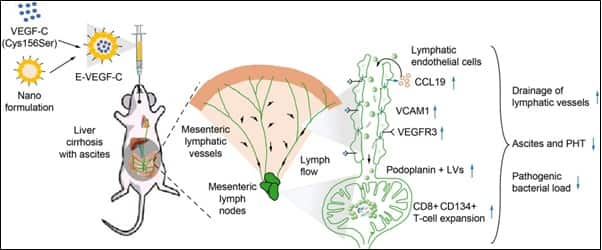New Delhi: A team of Indian scientists has found a new way to treat liver cirrhosis, by targeting the lymphatic vessels in the liver and intestine that fail in case of cirrhosis.
Chronic liver disease can progress from mild disease to fibrosis to cirrhosis (also known as scarring).
Cirrhosis is accompanied by the distortion of both blood and lymphatic vessels in the liver and the intestine. Patients with advanced cirrhosis often develop complications like fluid accumulation in the abdomen.
A team of scientists from the Institute of Liver and Biliary Sciences (ILBS), New Delhi, and National Institute of Pharmaceutical Education and Research (NIPER), Guwahati, focussed on improving the drainage capacity of lymphatic vessels in the liver and intestine by using nanocarriers filled with a powerful protein called VEGF-C.

Pic Credits: IANS
“Vascular endothelial growth factor-C (VEGF-C) is a key pro-lymphangiogenic factor that activates lymphangiogenesis or new lymphatic vessel growth. It does this through binding to a cell membrane tyrosine kinase receptor, vascular endothelial growth factor receptor-3 (VEGFR-3), the activation of which is essential for the growth and development of new lymphatic vessels,” said the researchers.
The team probed the therapeutic efficacy of VEGF-C in ameliorating gut lymphatic dysfunction and improving lymph drainage.
Owing to the hydrophilicity, short half-life, and systemic side effects of VEGF-C, the team led by Dr Subham Banerjee from NIPER Guwahati first focused on the development of VEGF-C encapsulated reverse micelle-based nanocarriers, which specifically bind to VEGFR-3 homodimers.
Next, the ILBS team, led by Dr Savneet Kaur, tested the developed VEGF-C nanocarriers extensively in animal models of advanced cirrhosis and portal hypertension.
The developed molecule was delivered via the oral route to ensure its gut lymphatic vessel uptake in the animal models. The team showed that VEGF-C nanocarriers significantly increased mesenteric lymph drainage, which reduced ascites.
Importantly, the treatment also led to an attenuation of the portal pressures, improved cytotoxic T-cell immunity in mesenteric lymph nodes, and reduced local and systemic bacterial load.
The research, published in the JHEP Reports journal, is the first to highlight that therapeutic lymphangiogenesis with VEGF-C is a promising treatment for reconstructing the fragmented lymphatic network and restoring lymphatic function and drainage in advanced cirrhosis.
Stay informed on all the latest news, real-time breaking news updates, and follow all the important headlines in india news and world News on Zee News.